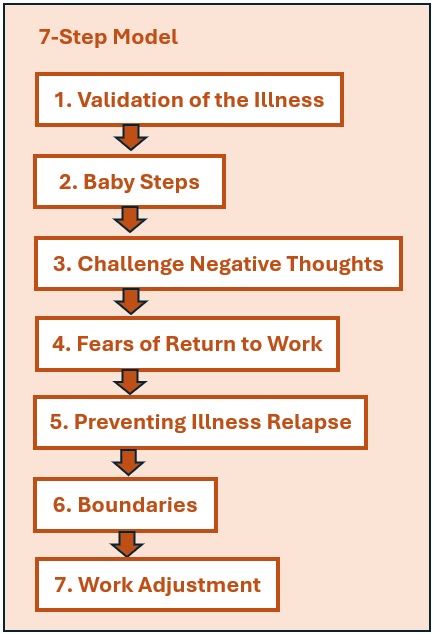March 2025 – 7-Steps to Improved Outcomes
This month I am very pleased to welcome a contribution from Dr Kristin Tugman, who many of you may know.
Dr Tugman has just launched her own consulting business, after building some great programs at some of the top disability insurance carriers in the US. The issues addressed are the same in every return-to-work situation, whether in Canada, Australia or the US, whether Disability Insurance or Workers Compensation!
Kristin has a PhD in psychology, is an adjunct professor at the University of Southern Maine and is a long-time friend of The Claim Lab. Kristin will introduce us to a 7-step model, that she has developed and successfully implemented for managing claims with psychosocial complexity.
I hope you find this interesting!
Ian Bridgman
The Claim Lab

The 7-Step Model
Dr Kristin Tugman
The experience of the inability to work due to an injury or illness is a psychological event. The psychology of disability and return-to-work may not be a diagnosable mental health condition, but it does require psychological adjustment that is critical to return-to-work success.
The disability experience can be categorized into three buckets; those claims that are predictable in duration and self-resolve, those claims that are unfortunately long term and are permanent in nature and a third bucket. This third bucket or middle bucket of claims are those that should be medically progressing but are not improving.
The middle bucket is where the opportunity lies for an intervention targeted to help the individual psychologically adjust to their circumstance and eventually return-to-work.
The 7-step model to enhance return-to-work outcomes is an approach designed to identify and overcome a set of common cognitive barriers that prevent adjustment and a successful return to productivity. All the barriers do not always appear, and they don’t always occur in the same order, but it is vital to identify these barriers and provide the skills necessary to overcome them to achieve a successful return to work outcome.

The 7 steps include:
1. Validation of the illness – Shame and guilt often accompany the inability to work, it is important to validate the need for treatment and to give permission to take the time away and engage in the treatment needed to recover.
2. Baby steps – These are incremental steps to recovery. This involves helping claimants set small goals they can achieve to demonstrate to themselves that they can recover.
3. Challenge negative thoughts – Cognitive distortions often take over and leave the person believing that the condition will never get better.
4. Fears of return to work – Claimants often experience tangible fears about returning to work that can paralyze their progress. It is important to identify these fears and develop a plan for each to help with preparation.
5. Preventing illness relapse – Illness relapse is often a concern when considering return-to-work. Identify the early warning signs of an illness relapse and the steps to take when and if the signs appear.
6. Boundaries – The idea of returning to an environment that requires long hours, and an unmanageable workload can prevent progress to return-to-work. Identify reasonable boundaries to help the claimant feel more prepared.
7. Work adjustment or Transitional return-to-work – When available, this is ideal and will allow the individual to return-to-work full-time, full-time duty incrementally over a brief period.
As soon as an individual experiences an inability to stay at work due to an illness or injury, there is a race to prevent the disability mindset and promote psychological adjustment.
The experience of disability is defined by consequences which can be either positive or negative. Disability management requires that the claimant believes they are prepared enough to be successful in their return-to-work such that they realize that the benefits of returning to work outweigh the consequences of returning to work.
The 7-step model to enhance return to work outcomes is an approach that can identify thought process barriers as they occur and provide a sense of security and preparedness for return-to-work success.
If you would like to learn more, please reach out to Dr Tugman at Email Here.
References:
Swanson-Tugman, K. (2013). “The lived experience of being out of work on short term disability: a phenomenological study.” Capella University, ProQuest, UMI Dissertation Publishing.
Tugman, K., “The Vocational Consultant’s Guide to Psychiatric Rehabilitation.” Elliott & Fitzpatrick. Athens, GA. 2002.
